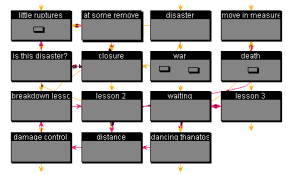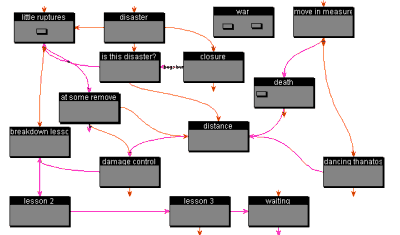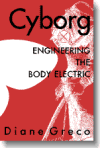hypertext maps
Hypertext mapping has long challenged writers, and perplexed hypertext system designers. Clear, attractive, and informative maps help readers and writers understand the structure of complex hypertexts. Conversely, in the absence of adequate mapping tools, many writers fall back on simplistic link models like sequential lists and outlines.
Trying to map an entire hypertext in a single view is usually unproductive: the result, for any large hypertext, tends to be a muddle in which hundreds of items are entangled in thousands of links. Automatic layout algorithms can help make good hypertext maps a little bit neater, but no satisfactory approach has been proposed for creating good hypertext maps in the first place. For a map to be informative, it must draw on knowledge of the meaning and intent of the hypertext. Representing the surface structure is not enough.
Although we lack good algorithms for generating effective hypertext maps, modern hypertext tools can render map-making a more pleasant and inviting task. Consider, for example, the map below: a screen shot of a Storyspace map from Diane Greco's hypertext Cyborg: Engineering The Body Electric. This hypertext examines the image of the cyborg -- the human being augmented through technological prosthesis -- in science fiction and contemporary thought.

In this Storyspace map, each box represents a separate writing space (sometimes called a "lexia" or "node" or "page"), and each line represents a link. A few of the spaces contain additional writing spaces nested within them; you can see the nested spaces drawn as small boxes inside some of the larger boxes.
The simple, rectangular arrangement reveals a sequence of topically-related pages, but obscures the tangle of links that connect them. A few minutes of rearrangement, however, lets us build a map that makes the pattern of linkage more evident:

Note that the patterns of connection are not simple, even after carefully unravelling the tangle; Greco's discussion of medical technology, textual criticism, gender, and fiction can't be coerced into a simple linear structure.
"I cannot imagine it as a printed text. Its hybrid form is so completely interwoven with the electronic prostheses through which we encounter it that the cyborg body is the text, and the text is the cyborg body. Which, I take it, is precisely Greco's point." -- N. Katherine Hayles, American Book Review
Notice, too, the many short arrows that seem to lead to (or from) nowhere; this is how Storyspace maps represent links that extend to spaces beyond the map. So even this map is only a fragmentary representation of the link structure, focusing on a portion of the hypertext and merely sketching its connections the the larger work.
Note, finally, the variety of paths through the work; readers may enter this section at many different points, may follow many different paths through the argument before they depart, and may later return to the argument from an entirely different angle. An earlier issue of Hypertext Now argues that recurrence is not a vice, but here the links here are carefully arranged to avoid small cycles: the many paths Greco provides are meant to be encountered separately, in different contexts, rather than exhaustively in a single exploratory session.
Hypertext maps have long been an area of active research, and the Storyspace map is but one of many visualization techniques. Such pioneering systems as Intermedia and NoteCards established but the utility and the limitations of conventional hypertext maps; spatial hypertext systems like Aquanet and VIKI were inspired, in part, by a desire to clean up the unsightly tangle of links that make conventional hypertext maps so complex. Progress continues, although dramatic breakthroughs have proved elusive; indeed, the graceful curved links used in Storyspace for Windows [and Tinderbox -- ed] originated in the seminal work of Professors Marc and Jocelyne Nanard at Montpellier.
Constructing informative maps is more than an exercise in geometry; layout needs to consider meaning and role as well as line lengths and intersections. Fortunately, although hypertext systems still cannot generate good maps on their own, hypertext software can help render map-making a straightforward, and even pleasant, task.

